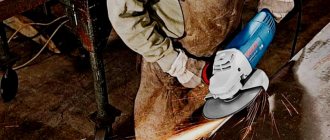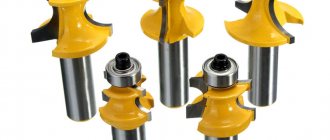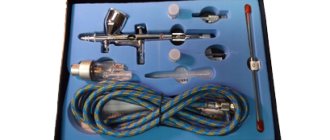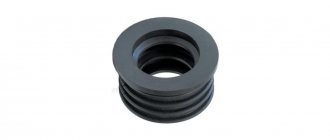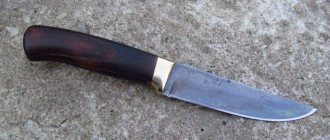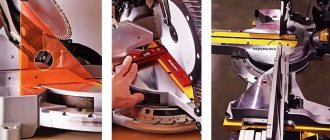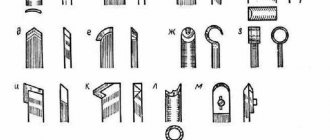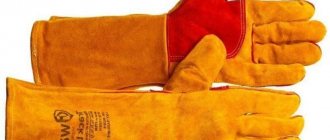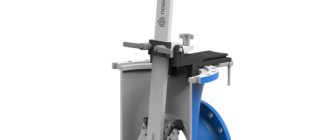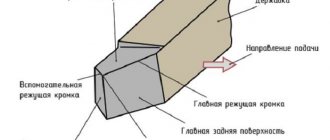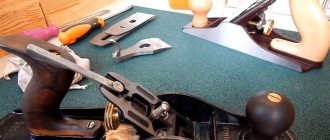An angle grinder (angle grinder), popularly known as a “grinder”, is a professional universal device that is used for a variety of purposes. With its help you can carry out many works: cutting, grinding, polishing, sawing and processing various raw materials. When choosing a suitable model, you must understand its design features, assess your financial capabilities, and also consult with a specialist.
Due to the wide variety of models available, choosing the perfect solution can be a disaster. In any case, the emphasis should be placed on the purpose of the proposed equipment. Wooden structures require appropriate grinding wheels for wood grinders. The same goes for metal - it is processed only with suitable tools.
The nuances of working with an angle grinder on wood
Professionals rarely use a grinder specifically for working with wood; there are special devices and tools for this - a belt sander, an electric saw, a jigsaw. But in everyday life, if there is a need to perform woodworking work, it is not practical to buy a whole set of expensive tools, then a grinder with an attachment for sanding wood comes to the rescue.
Sawing
The grinder is not the most popular tool for sawing wood, since it is a material with a fibrous structure. With insufficient fixation and the slightest vibration and change in the cutting angle, the fibers rise, delaminate, chips, defects and scattering of sawdust and chips are formed.
Cutting wood with an angle grinder Source mplus.ru
The cutting attachment is justified only if the angle grinder is fixed as firmly as possible on the cutting table. Using a grinder, you can only make a rough cut, not a precise cut, since it is impossible to organize compliance with all the conditions for precise work - rigidly fix the material, the tool and see the cutting location.
Attention! Cutting wood using abrasive or diamond wheels is strictly prohibited; this can lead to the disc breaking and overheating of the tool.
Sanding and polishing
The grinder is excellent for grinding. The work is carried out according to the following algorithm:
- Preparatory work . Initially, rough grinding is done using a roughing attachment. It looks like a bowl with twisted wire located around the entire perimeter (outwardly similar to a brush with metal bristles). At this stage, the old layers of paint and varnish materials are removed from the board.
- Preliminary (rough) grinding . Remains of coating, protruding fibers and other defects are removed from the surface of the material. Work is carried out using grinding wheels for grinders on wood. At this stage, the material is prepared for painting.
Sanding wood with a grinder Source szlif-tech.pl
- Final (fine) sanding . Used for wood that will not be painted. For work, an attachment for an angle grinder is used for sanding wood with an abrasive of minimal grain size - zero.
- Polishing . Produced at low engine speeds, fabric wheels are used as an abrasive.
In order to carry out all the processes as conveniently and efficiently as possible, it is necessary to choose the right nozzle from the whole variety of their modifications.
Choosing a suitable grinder for cutting and processing wood
If you have to cut wood material, then you can do it with a grinder, but taking into account the correct choice of tool. Grinders are produced in different sizes and power, which determines the possibility of using attachments with a diameter of 115, 125, 150, 180 and 230 mm. An angle grinder for 115 mm cutting discs for wood is not the best solution. This is due to the following disadvantages:
- A small disk is installed on the tool, which is practically impossible to saw or process anything
- Inconvenience of working with a small grinder when processing large surfaces
The best solution for cutting wood with a grinder is a tool for circles with a diameter of 125 mm. It not only allows for efficient cutting of material, but is also considered to be as safe as possible. However, they are not so safe that they can be used even by beginners. It is better not to use tools with 150, 180 and 230 circles for cutting wood, since the high power of such grinders requires a lot of effort.
This is interesting!
An angle grinder is not a chainsaw or an electric saw, so it should not be used for cutting wood without proper skills.
The safest option is considered to be an angle grinder for wheels with a diameter of 125 mm. This is the type of machine that should be used when you need to use a tool for sawing woodworking materials. Before you buy an attachment with teeth for cutting wood, you need to take into account not only its outer diameter, but also its inner diameter - the mounting hole. For modern standard tools, discs with a diameter of 22.2 mm are available.
Types of disks for wood processing
The construction tools market is expanding every year. What types of wheels there are for an angle grinder, we’ll take a closer look below:
For cutting
Some blades are designed for sawing large and small pieces of wood:
- Plane.
Used for rough processing of wood. The nozzle is durable, solid. Installed only on angle grinders with two handles.
Disc plane for grinder Source thewoodwhisperer.com
- Chainsaw.
Most effective for working with wood. Used for removing bark, trimming and sawing tree branches, boards of small thickness (up to 4 cm) - plywood, parquet, chipboard, fiberboard. It is considered the safest - when the grinder jams, the chain remains in place, and the circle makes idle turns.
Chain saw blade for angle grinders Source yandex.net
- Segmental (tungsten carbide).
It does not have teeth; instead, there are segments around the circumference. It is distinguished by increased strength - it will cut not only wood, but also randomly encountered hardware.
Tungsten carbide wheel Source diskitrio.ru
- Few teeth.
Safest when working with wood. Suitable for both longitudinal and cross cuts, for cutting grooves in workpieces. There are models with 3 and 4 teeth.
Saw blade with a small number of teeth Source domingo.su
- Saw.
They differ in the number of teeth and material. For wood, cutting wheels with a small number of teeth are used.
Saw blade with medium number of teeth Source skladom.ru
See also: Catalog of companies that specialize in the design and installation of house structures for various purposes - sheds, greenhouses and others
Roughing
These discs perform primary processing of wood parts:
- With baby.
Used for rough processing of wood. There are models with different sizes of abrasive chips.
Peeling disc with crumbs Source prom.st
- With spikes.
Used for leveling various wooden surfaces. The nozzle aligns the junction of two boards and they are joined in the same plane.
Peeling disc with spikes Source amazon.com
- End.
Designed for processing cuts of wooden blanks. Convenient for materials with oblique (corner) cuts.
End grinding disc Source metabo.com
- Glass with wire bundles.
Used for rough cleaning of wooden surfaces from paint and varnish materials.
Glass for angle grinders with wire bundles Source mplus.ru
- Brush with wire bundles.
Another disc option for rough cleaning of wood surfaces.
Brush for angle grinders with wire bundles Source bobrujsk-praktik.by
Wheels for grinder
We propose to talk about disks, which are no less useful than attachments (but the latter will also be discussed).
- Grinder chain saw. If it seems to you that a standard chain disk will not be enough, then in fraternal China local manufacturers took care of this and designed an attachment that makes a small chain saw from the simplest grinder. Now you can forever forget about dangerous saw blades for wood.
If you need not to cut, but to make a groove, this will not be a problem, because a special milling disc for an angle grinder helps to mill the wood, and also leaves a groove with a width of 2.1 cm.
Milling disc.- Petal circles. If you need to sand not a straight board, but a product that has a lot of bends, dimples and complex contours, then such a flap disc will be an excellent helper. This sanding disc is very popular for repairing old pieces of furniture when it is necessary to remove the finish and apply a new coat.
- Grinder. If you have other grinding tasks, the new Chinese-made attachment helps turn your angle grinder into a real grinder.
- Ripping disc. What about this hedgehog? Such discs can be of different grain sizes, they are very reliable and durable, but they can only be used on wood, because otherwise they will fly off (when used on metal).
As you can see, there are also many useful disks. We hope you find this information useful.
Features of choosing a disk for wood
Grinder circles are produced in standard sizes. The minimum size is 11.5 cm. This tool is compact, but inconvenient for a large amount of work. The optimally convenient and safe tool with a 12.5 cm wheel. Anglers with 15 cm discs are inconvenient for processing wood and create conditions for increased injury.
When choosing a wheel, you need to focus on the markings indicated on the disk - its diameter, thickness, seat size, maximum permissible rotation speed, shelf life of the wheel and the material that can be processed with it.
Disc marking for an angle grinder Source yandex.net
If you install a larger disc on a grinder than specified by the manufacturer, you may exceed the speed of the cutting edge, break the wheel, and cause injury. In addition, a small angle grinder may not have enough power to rotate a large disk. The most dangerous thing is that installing a large circle will require dismantling the protective casing, which can lead to injury when cutting wood.
Grinding
The grinding disc is selected depending on the nature of the work being performed. For roughing and roughing work, wheels with coarse abrasive and wire are suitable. The higher the grinding quality, the finer the grains of the abrasive material.
Grinding disc Source tehnomuza.ru
Convenient grinding wheels with the ability to change abrasive discs of different grain sizes, attached with Velcro. The price of these replacement materials is low, but their service life is also short.
For finishing a wooden product – polishing – circles made of felt and pressed wool are used.
Cut-off
It is advisable to approach the choice of a cutting disc more responsibly, since sawing work is characterized by increased injury.
Do not process wood with discs intended for metal, stone or ceramics. To work with them, higher strength and higher speeds are required. In wood, such a circle can get stuck, break, and the instrument will burn.
Cutting disc Source alicdn.com
How to choose the grit of a sanding wheel for wood
September 04, 2021
Anatomy of an Sandpaper Sandpaper or sanding wheel consists of three main components: the abrasive, the backing material and the binder.
What is a grinding wheel? A grinding wheel is an abrasive cutting tool. It can be used for manual surface processing or for use on machines or special grinding devices. For example, professionals demand a grinding wheel for a sharpener with a grain size that will ensure the most efficient use of the tool.
Grinding wheels are classified according to many parameters. The presence of abrasive materials and binding elements is mandatory for each type.
The grains of the abrasive material can be made of:
- silicon carbide;
- diamond (artificial or natural);
- electrocorundum;
- elbora.
It is the grain size of grinding wheels that determines their main functional purpose. An abrasive cuts microscopic chips from parts or material. As for the ligament, it can be of artificial or natural origin. The purpose of the binder is to firmly hold the grains together.
In addition, there are necessarily pores on the surface of the grinding wheel. Due to the space not filled by the ligament - microscopic pores - roughness is formed on the surface. Some manufacturers provide grinding wheels with specific impregnations to reduce the temperature in the processing area. Such instruments are called “impregnated”.
Abrasive material is a substance ground to fine grains. To produce sandpaper, various types of abrasives are used: aluminum oxide (electrocorundum), silicon carbide, garnet, glass, CBN, etc. The size of the abrasive particles determines the most important characteristic of the sanding paper - its grain size, which we will talk about in more detail.
The backing is a paper or fabric base onto which the abrasive material is glued. The fabric is more often used for belts, rolls and some types of sanding discs. Paper is commonly used for sanding sheets and most types of discs. Along with paper and fabric substrates, you can find options made from polyester materials.
Binder is a layer of adhesive that holds abrasive grains. Hide glue, synthetic resin (a more durable option), or a combination of these two materials are used as a binder.
Let's understand the types of coatings For various works with wood: rough processing, preparation for applying finishing, interlayer sanding of coatings, polishing, etc., the following types of abrasives are traditionally used.
Aluminum oxide (electrocorundum) . It is characterized by high density and resistance to crushing. The most common abrasive for sanding wood and metal. Recommended for sanding untreated wood.
Silicon carbide . During operation, the crystals of this abrasive split, forming new cutting edges. This feature of the grains ensures the self-sharpening of the skin and prevents it from quickly clogging. Sandpaper coated with silicon carbide is recommended for delicate sanding, for example, interlayer sanding of finishing coatings.
Pomegranate . Relatively soft mineral abrasive. It has the ability to self-sharpen, but wears out quickly. Traditionally it is used for finishing sanding of treated and untreated wood.
Aluminum ceramics . This is aluminum oxide that has undergone additional high-temperature treatment. Its abrasive properties are higher than those of its unfired counterpart. It is characterized by maximum wear resistance and is optimal for processing wood at various stages.
How not to make a mistake with grain size? Grit is the most important characteristic of sanding paper. When the hackneyed question comes up: what sandpaper to sand wood with, they usually mean not so much the type of coating, the nature of the binder, etc., but rather the grain size.
The suitability of sandpaper for a particular type of work depends on the gradation of grain size. At first glance, everything seems simple, but in practice, choosing the right skin is often complicated by confusion in labeling by numbers.
It so happens that there are several sandpaper standards in active use on the modern market: the international classification ISO 6344 (the new Russian GOST R 52381-2005 fully complies with it), the old Soviet marking (GOST 3647-80) and the American standard (CAMI).
TABLE: TYPES OF SANDYPAPER GRAINS, PURPOSE OF ABRASIVE, RATIO OF MARKINGS
| Purpose of abrasive | Marking according to ISO-6344 (GOST R 52381-2005) | Marking according to GOST 3647-80 (Soviet standard) | Marking according to CAMI (American standard) | Grain size, microns |
| Coarse abrasives | ||||
| Rough wood processing | P40 | 40-N | 40 | 400-500 |
| P46 | 32-N | 50 | 315-400 | |
| P60 | 25-N | 60 | 250-315 | |
| Primary sanding Leveling the wooden surface | P80 | 20-N | 200-250 | |
| P90 | 16-N | 80 | 160-200 | |
| P100 | 12-N | 100 | 125-160 | |
| P120 | 10-N | 120 | 100-125 | |
| Preparing hard wood for finishing Final sanding of soft rocks Sanding old paint for painting | P150 | 8-H | 150 | 80-100 |
| P180 | 6-H | 220 | 63-80 | |
| Fine abrasives | ||||
| Finish sanding of hardwood Sanding between coats | P240 | 5-N, M63 | 240 | 50-63 |
| P280 | 4-N, M50 | 40-50 | ||
| Final sanding of the finishing coating Polishing | P400 | M40/N-3 | 28-40 | |
| P600 | M28/H-2 | 360 | 20-28 | |
| Ultra-fine sanding Removing micro-scratches | P1000 | M20/H-1 | 600 | 14-20 |
What is open and closed abrasive loading? Based on the characteristics of the application of abrasive material, sandpapers with open and closed filling are distinguished. This is another important parameter that you should pay attention to when choosing sandpaper for working with wood.
In open and semi-open sandpaper, abrasive grains cover from 40 to 60% of the working surface. The sparse filling of grains prevents the abrasive from quickly clogging with wood chips, resin, paint and other waste. This sandpaper is optimal for machine sanding, processing wood for painting, and working with soft and resinous woods.
In closed- or solid-fill sandpaper, the abrasive grains cover the entire working surface. This type of sandpaper is more effective for manual sanding, working with hard wood, and finishing polishing.
How to extend the life of an abrasive? As the abrasive grains become clogged with chips and wood resin, the sandpaper loses its working properties. A clogged abrasive, especially when machine sanding, leaves dark marks, compresses the fibers and polishes the surface, which is why the wood does not absorb the finishing compound well.
To make abrasives last longer, start with a coarser sandpaper and gradually move to finer-grain paper. For soft and resinous woods, use sanding paper with a sparse coating and a special stearate coating (a dry lubricant that prevents rapid clogging of the abrasive).
When working with a sander, take your time. Overheating the surface leads to softening of the binder and accelerates wear of the abrasive grains. An important factor is the storage conditions of the grinding material. Cold and critical humidity can render it unusable. The optimal storage temperature is 15-25°C with a relative air humidity of 35-50%.
How to clean sandpaper from wood dust? Traditionally, a special cleaning bar made of natural rubber is used to clean clogged abrasives.
A piece of garden hose or, no matter how ridiculous it may seem, a worn-out sneaker can cope with this task no less successfully.
All of the above cleaning methods are more relevant for grinding machine abrasives. To clean regular sandpaper, you can use a brush with stiff plastic bristles.
Work rules and safety precautions
Processing wood with angle grinders requires a serious attitude and strict adherence to the rules of operation of the device and personal safety:
- It is strictly forbidden to remove the protective cover during operation. If the working disk breaks, it will prevent injury to the face and body from fragments.
- For woodworking, preference should be given to medium-power angle grinder models. If the process fails and the tool jams, it will be much easier to hold it in your hands compared to a more powerful one.
- Grinding discs are much safer to use than cutting discs. When using them, it is advisable to use a mask to prevent wood dust and small sawdust from entering the respiratory tract. It is also advisable to wear safety glasses.
Workwear and protective equipment when sanding wood with an angle grinder Source kraskistroi.ru
- When working with cutting attachments on an angle grinder for processing wood, you must strictly adhere to a right angle, otherwise the cutting will occur unevenly and the angle grinder may jam.
- You cannot use discs that do not match at least one of the parameters for the angle grinder model you are using.
- It is strictly forbidden to use discs even with minimal signs of damage, especially when cutting wood.
- It is prohibited to install circles from a circular saw or other tools instead of a disc on a wood grinder. Circular discs are designed for operation at low speeds and on angle grinders they can simply warp or break and fly apart.
- Before sanding wood with a grinder, it must be thoroughly dried. Damp wood is difficult to sand and is more likely to be damaged by mold and mildew.
Briefly about the main thing
The grinder is a universal tool designed for working with various materials, including processing wood bases. Sanding and cutting discs for wood perform various functions:
- removing bark, pruning and sawing branches and trees;
- rough, rough, final sanding of wood;
- surface polishing;
- rough and fine cutting of boards, fiberboard, chipboard.
But we must understand that this is all true only for those whose work related to wood processing is not income. The grinder is suitable simply for minor household chores - repairs, installation of a fence, replacement of flooring. The necessary discs will help you cut, clean, and sand wooden materials and products. But if you have to work with wood often, then a specialized tool will be much more practical.
Plus, you must always remember that a universal grinding machine is a high-risk tool - when performing work, it is imperative to follow safety precautions.
Ratings 0
